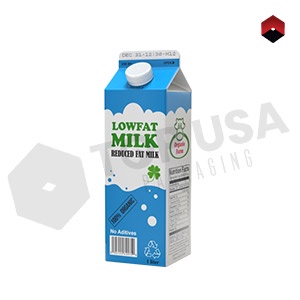Introduction
Milk cartons have become an integral part of our daily lives, serving as vessels for one of the most widely consumed beverages worldwide: milk. From the traditional paper cartons to more modern and sustainable alternatives, milk cartons come in various shapes, sizes, and materials. In this extensive exploration, we delve into the realm of milk cartons wholesale, dissecting the industry, its trends, environmental considerations, and the factors contributing to its continuous growth.
I. The Milk Carton Industry
1.1 Historical Overview Milk cartons: have a rich history dating back to the early 20th century when they were first introduced as a means to preserve and distribute milk. The shift from glass bottles to cartons revolutionized the dairy industry by extending the shelf life of milk and making transportation more efficient.
1.2 Industry Size and Scope :The milk carton industry is a substantial segment of the packaging sector. It encompasses a vast network of manufacturers, suppliers, and distributors. The demand for milk cartons, both for wholesale and retail purposes, has grown consistently over the years due to the enduring popularity of dairy products.
1.3 Key Players: Several major players dominate the milk cartons wholesale market. Companies such as Tetra Pak, Elopak, and Evergreen Packaging are known for their innovative carton designs and sustainable packaging solutions.
II. Types of Milk Cartons
2.1 Traditional Paper Cartons :The classic milk carton, made from paperboard coated with a layer of plastic or wax, is still widely used. It remains a popular choice for consumers and manufacturers due to its affordability and recyclability.
2.2 Aseptic Cartons :Aseptic cartons are designed to keep milk fresh without refrigeration for extended periods. These cartons are made of multiple layers of materials that provide an excellent barrier against light, air, and microorganisms, ensuring the preservation of milk's quality.
2.3 Sustainable Alternatives: In recent years, the industry has witnessed a surge in demand for sustainable packaging options. Milk cartons made from renewable materials like plant-based plastics, biodegradable materials, or recycled content have gained popularity, catering to environmentally conscious consumers.
III. Trends in Milk Cartons Wholesale
3.1 Eco-Friendly Packaging :Consumers are increasingly concerned about the environmental impact of packaging. As a result, there is a growing demand for milk cartons that are recyclable, biodegradable, and made from sustainable materials.
3.2 Customization and Branding Customized milk cartons :have become a trend, allowing dairy companies to differentiate their products in a competitive market. Eye-catching designs, branding, and messaging on cartons can enhance brand recognition and consumer loyalty.
3.3 Convenience Features: Milk cartons are evolving to offer more convenience to consumers. Features such as resealable spouts, easy-pour openings, and ergonomic handles make cartons more user-friendly and attractive to consumers.
IV. Environmental Considerations
4.1 Recycling and Sustainability :The milk carton industry is making strides in improving the recyclability of its products. Many cartons are now designed with recycling in mind, and efforts are being made to reduce their environmental footprint.
4.2 Reduced Plastic Usage :Efforts to minimize the use of plastic in milk carton packaging are ongoing. Innovations like plant-based plastics and reduced plastic layers in carton designs contribute to a more sustainable future.
4.3 Waste Reduction :Manufacturers are working to reduce waste during production by optimizing carton designs and minimizing material waste. These efforts align with broader sustainability goals.
V. Factors Contributing to Growth
5.1 Consumer Preference: The enduring popularity of milk and dairy products ensures a consistent demand for milk cartons. Consumers seek convenience, freshness, and eco-friendly packaging, which drive the industry's growth.
5.2 Technological Advancements: Advancements in carton design and manufacturing technologies have led to improved product quality, longer shelf life, and more sustainable options, contributing to market expansion.
5.3 Globalization :The globalization of the dairy industry has expanded the reach of milk cartons wholesale. Manufacturers and suppliers are tapping into international markets, fostering industry growth.
Conclusion
The world of milk cartons wholesale is a dynamic and evolving landscape, driven by consumer preferences, technological innovations, and environmental consciousness. As demand for milk and dairy products continues to rise, the industry must adapt to meet changing expectations for sustainability and convenience. With a focus on eco-friendly practices and innovative designs, milk cartons are likely to remain a staple in our lives for years to come, making a significant contribution to both the packaging and dairy industries.


No comments yet